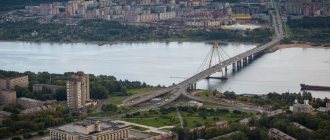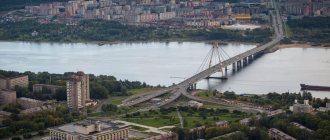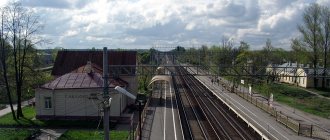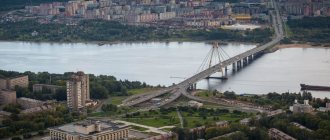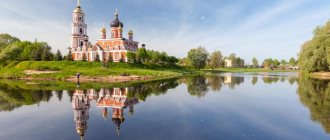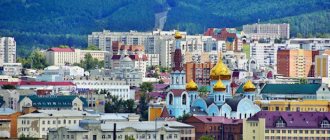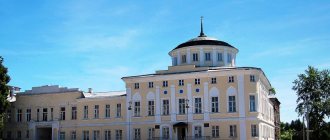Sortavala is a small European town on the shores of Ladoga, which, by the will of fate, became part of Russia. This is one of the most ancient cities in Karelia, and the sights of Sortavala are of great value and are included in the list of historical and cultural heritage of the all-Russian level.
The city attracts with its architecture, which incorporates the features of cozy European cities, northern Ladoga landscapes and the proximity of the island of Valaam. This is the second most popular city among tourists in Karelia after Petrozavodsk - both lovers of outdoor activities and pilgrims heading to the Valaam Monastery come here.
Interesting things about Sortavala
- The lands on which Sortavala is located today were inhabited by the ancestors of modern Karelians more than 8 thousand years ago.
- The historical name of the city is Serdovolye. For centuries before the advent of Peter the Great, it was constantly conquered by either Russian or Swedish soldiers. Regular changes from hand to hand and the outflow of the local population turned the city into a run-down and impoverished village of Serdobol - as wild rose was called in these places. Only Empress Catherine II managed to give the settlement a second life, returning it to the status of a city.
- After the revolution of 1917, the city again became Finnish territory - it was then that it received its current name. As a result of the Russian-Finnish war of 1939, it became Soviet, but not for long - after a couple of years Sortavala was occupied by the Finnish army. After the liberation of Karelia, the settlement was finally transferred to the USSR, but the Finnish name was preserved.
- Sortavala has been included in the list of historical cities of Russia since 1990.
- The population of the city is 18.8 thousand people.
- Russians, Ukrainians, Belarusians, Karelians and Finns live in Sortavala.
- Sortavala is the only city in the republic that has preserved its historical appearance. The nearly 200 buildings in the city center are built in a variety of styles.
- The name of the city is pronounced in the Finnish manner - with emphasis on the first syllable. The word "Sortavala" is not inclined.
- The city has the youngest monument to Lenin in Russia - it dates back to 2010.
- For some time, the famous Russian philosopher and artist N.K. lived in Sortavala. Roerich.
- The distance to St. Petersburg and Petrozavodsk is approximately the same - about 250 km, to the border with Finland - 60 km, to the island of Valaam - 42 km.
- The nearest city is Lakhdenpokhya, located 42 kilometers away.
- The central street of Sortavala is Karelskaya.
Architectural objects and monuments of Sortavala
Sortavala, whose attractions are mainly located in its central part, has preserved unchanged the example of the layout of a European city. This area of the city is known as a museum of European architecture of the early 20th century.
Leander House
In the center of Sortavala there are many buildings made in the Art Nouveau style. These include the Leander House, which was built in 1905 according to the plans of the Finnish architect E. Saarinen. It is located at the intersection of the street. Karelskaya, st. Gagarin and Main Square.
The unusual exterior decoration attracts the eye - high stove heating pipes, original shaped windows, a facade with floral patterns. The interior decoration was also distinguished by its elegance, but now only small fragments of it have survived - stoves with colored tiles and a central staircase.
A branch of the Finnish National Bank opened in a stone building that looked like a small castle. The name of the house is usually associated with the name of the second director of the bank. But there is an assumption that the customer of the building was a representative of the Leander city council.
Finnish Bank building
The monumental two-story stone building, which was built in 1915 in a neoclassical style with elements of neo-romanticism by the architect from Vyborg U. Ulberg, is distinguished by its severity and consistency of lines.
The cladding of the facade of the building, which is considered the main architectural value of the city, is entirely made of local gray granite, called Serdobol. The main entrance stands, bas-reliefs of the bank's emblem, flower beds, and heavy window sills are also hewn from Serdobol granite. The architectural monument is located on the street. Väinemäinen.
Siitonen Merchants' House
The building that currently houses the city administration is of historical and architectural interest. Built in 1907 by order of the merchants K. and N. Siitonen by the architect P. Uotila, the apartment building is made in the Art Nouveau style. Wide panoramic windows add air to the austere building.
The difficult-to-pronounce surname of the building's owners comes from the Russian surname Sidorov, which was difficult for Finns to pronounce. The premises on the first floor were rented out for shops, and apartments were located on the second and third floors.
Museum named after Kronid Gogolev
Website: www.artgogolev.ru
Kronid Gogolev is a famous Karelian craftsman, the author of many paintings and wooden figures, and a master of relief wood carving. In his works he reflected the life and nature of the Russian North.
The museum, dedicated to the work of Kronid Gogolev, carefully preserves and presents not only unique examples of wood carving, but also paintings made in different techniques. Vernissage workers regularly carry out mass work - they give lectures, conduct master classes and excursions for everyone.
On weekends, the institution organizes Open Days, where visitors are not only introduced to the amazing creativity of wood carving masters, but also told about the rich history and culture of the city.
Regional Museum of the Northern Ladoga Region
Website: museum-sortavala.ru Address: Ladoga Flotilla embankment, building 5.
This is the only institution in the city that functions both as a museum and as a local history center. Here you can get acquainted with the history of the region and see unique exhibitions, including the armor of Swedish warriors, samples of rare rocks, works of Karelian folk craftsmen on the subjects of their epic “Kalevala”, photographs, handicrafts and much more.
It must be said that the institution has a fairly large number of interesting exhibits for a regional-level museum - perhaps this can explain its enormous popularity among tourists.
Monument to the Rune Singer
Rune singers were the name given to performers of runes—epic folk songs of the Finno-Ugric peoples. Often the singing was accompanied by playing the kantele, a folk musical instrument of the Karelians.
Getting to such a landmark of Sortavala as the monument to the rune singer is not difficult - just go to the park on Vainamainen Square. The statue was installed in Sortavala in 1935 and dedicated to the centennial anniversary of the first edition of the world famous epic “Kalevala”.
The statue of a gray-bearded old man holding a kantele on his knees is a collective image dedicated to all Karelian rune singers. However, a number of sources say that this is a monument to a specific person - the rune singer Petri Shemeikka, who lived in these parts in the 19th and early 20th centuries.
St. Nicholas Church
St. Nicholas Church, also located in the historical center of Sortavala, is one of the first stone buildings in this city of the 2nd half of the 19th century. It is impossible to pass by this stunningly beautiful snow-white building with sky-blue domes and gilded domes, almost entirely built at the expense of the capital merchant Eliseev.
The temple is crowned with a large dome, on top of which there is a so-called anchor cross - an element inherent in religious buildings of the pre-Mongol period. Today, both the church building itself and the surrounding areas are constantly being improved.
Sortavala Town Hall
Another decoration of Sortavala is the small wooden building of the city hall, built in 1885. By the way, one of the few wooden buildings in Sortovala that survived the fire of 1903. Nowadays the former town hall houses the city library. On the facade, right under the roof, there is a window with an arched pediment - before the Second World War, the medallion of this window had the coat of arms of Sortavala on it. The roof of the building is topped with a small turret with a spire and a weather vane.
Karelian Bridge
Karelian Bridge Sortavala
The city of Sortavala is located on the shore of Lake Lyappajarvi, which is part of the waters of Lake Ladoga and dissects the city into two halves. The Karelian Bridge, built in 1932, connects the city and is a continuation of Karelian Street. The length of the reinforced concrete bridge is 220 meters, width is 11 meters.
Architecture of Sortavala
The unique architectural ensemble of Sortavala took shape over decades, mainly from the end of the 20th century to 1939. Stone buildings organically alternate with wooden ones. In total, about 200 historical buildings created by famous Finnish architects in different styles have been preserved in Sortavala. Here you can see eclecticism, a type of modernism - Finnish national romanticism, pseudo-gothic, neoclassical and functionalism.
Town Hall
Former town hall building
Address: st. Lenina, house 18. Year of construction: 1885. Style: eclecticism. Architect: Frans Anatolius Sjöström.
The Sortavala Town Hall building is located in the city center, next to the Lenin monument, and is the oldest in the city. Once upon a time, the city council met here and the burgomaster worked here. The main hall of the town hall was the venue for all significant city events. During Soviet times, there was a party office here, and later a library, which moved out in 2013 due to the disrepair of the building. Now the building of the former town hall is empty.
Sortavala forestry
Address: st. Ladozhskaya, house 1. Year of construction: 1900. Style: Finnish romanticism. Architect: Johan Alvar Åkerman
The Sortavala forestry building once housed a Finnish hotel and store.
Leander House
Address: st. Karelskaya, house 13. Year of construction: 1905. Style: Finnish romanticism. Architects: Eliel Saarinen, Armas Lindgren and Hermann Gesellius.
This most famous architectural landmark of Sortavala now houses a branch of Sberbank. Initially, Leander's house was built for the National Joint Stock Bank; the bank's management lived on the second floor. The customer of the building was Oscar Leander, a famous architect and director of the above-mentioned bank.
United Nordic Bank
Address: st. Karelskaya, house 19. Year of construction: 1913. Style: Finnish romanticism. Architect: Uno Ulberg
The building was built at the beginning of the 20th century for the United Bank of the Nordic Countries. Nowadays the Russian Post and Post Bank are located here.
The building of the Sortavala girls' school
Building of the Sortavala girls' school (1911)
Address: st. Gagarina, house 14. Year of construction: 1911. Style: pseudo-Gothic. Architect: Johan Jakob Arenberg
Once upon a time there was one of the best Finnish schools; in Soviet times there was a physical education college, a school, and a boarding school. Now the well-preserved building houses the district library.
Hotel Seurahuone
Address: st. Karelskaya, house 22. Year of construction: 1939. Style: functionalism. Architect: Erkki Huttunen
Hotel Seurahuone was built on the site of an old hotel as a multifunctional modern building. The previous building was built in 1909 by the architect Onni Tarjanne in the Nordic Art Nouveau style. During the Soviet years, the House of Officers was located here. Now there is a hotel, cafe, cinema and youth center.
Finnish bank
The building of the former Bank of Finland
Address: st. Väinämöinen, house 4. Year of construction: 1915. Style: neoclassicism. Architect: Uno Ulberg.
The building of the former Finnish Bank in Sortavala was built at the beginning of the 20th century. It is completely lined with granite, which gives the building a strict, monumental and slightly gloomy appearance, making it look like a medieval castle. The historical function of the building continues to this day - today a branch of the Bank of Russia is located here.
The best attractions in the vicinity of Sortavala:
Mountain Park "Ruskeala"
Mountain Park "Ruskeala"
30 km from the city there is a park located on the site of an old marble quarry. By the 19th century, the quarry was mined out and abandoned. Gradually lakes and rivers formed here. The place is so beautiful that at the beginning of the third millennium, tourism infrastructure began to be developed here.
An incredibly beautiful place - you need to admire the Karelian nature here. Worthy of attention are the Marble Canyon, the Italian Quarry, and the Ruskeala Gap. In addition, the park is well-equipped - cafes, souvenir shops, and many observation platforms are available to visitors. Hotels and recreation centers are located nearby.
Address: Ruskeala, Mramornaya street, Republic of Karelia, Russia
Opening hours: daily from 9:00 to 21:00; seven days a week
Entrance: for adults – 400 rubles, for children – 150 rubles, children under 7 years old free
Official website: https://ruskeala.ru/
Ruskeala waterfalls
Ruskeala waterfalls
Located on the Tohmajoki River, there are only 4 waterfalls. They are quite low (4 m), but are brown in color (there is a lot of iron in the local water).
It’s worth coming here to admire nature, stroll along the hanging bridges, and even go kayaking. There are a couple of cafes nearby that serve local fish, as well as a souvenir shop. By the way, this place is well known to TV viewers. The old film “The Dawns Here Are Quiet” was filmed here.
Address: Ruskeala, Mramornaya street, Republic of Karelia, Russia
Opening hours: daily from 10:00 to 21:00;
Entrance: for adults – 200 rubles.
Official website: https://ruskeala.ru/
Karelian Zoo
Karelian Zoo
A huge zoo (30 hectares) with local animals. The main emphasis is on ungulates - deer, llamas. Plus, more than 150 birds live here. Animals live in the most natural conditions possible.
The zoo will appeal to children - there is a contact department. Also here you can pet and feed sheep, rabbits, and ponies. Nearby there are camp sites for lovers of nature recreation and fishing.
Address: pos. Kirkkolahti, Republic of Karelia, Russia
Opening hours: daily from 10:00 to 19:00
Entrance: for adults – 500 rubles, for children – 300 rubles, children under 3 years old free
Official website: https://kareliazoo.ru/
Tohmajoki River
Tohmajoki River
The river flowing near the city flows into Lake Ladoga. A very picturesque body of water, most tourists know Tohmajoki because of the Ruskial waterfalls, which are located in its flood.
But rafting connoisseurs appreciate the reservoir for its length of descent (from 45 km) with many rapids and dams. But such a journey takes about 3 days.
Address: Tokhmajoki River, Republic of Karelia, Russia
When to visit : any time
Free admission
Lake Janisjärvi
Lake Janisjärvi
A natural attraction is a clean and in some places very deep lake (up to 57 meters). It is believed that the lake's depression is a trace of a fallen meteorite.
The lake attracts fishermen - there is a very diverse underwater world here. In addition, calm water and picturesque shores attract lovers of water recreation - there are convenient tourist centers nearby.
Address: Lake Yanisjarvi, Sortavala district, Republic of Karelia, Russia
When to visit: any time
Free admission
Doctor Winter's cottage
Doctor Winter's cottage
Country house on Cape Taruniemi. Time of creation 1909. The dacha belonged to a local native, surgeon and public figure Gustav Winter.
The estate has two floors - the first floor is decorated with stone, the second is made of wood. There is a park around the building with many coniferous plants. Now there is a park hotel here, but there is also a museum exhibition.
Address: Tarulinna village, Sortavala, Republic of Karelia, Russia
Opening hours: daily
Free admission
Official website: https://dachawintera.ru/
The dacha of the pharmacist Jaskeläinen
The dacha of the pharmacist Jaskeläinen
The building was created in 1935 by the Finnish architect Blomsted in the style of romanticism and functionalism. The cottage is located on the shore of Kiryavalahti Bay, 20 km from Sortavala.
The attraction is interesting due to its harmonious fusion with the surrounding nature. Stone and wood were used in construction and decoration.
Since the middle of the century, the dacha has been occupied as a creative house for the Union of Composers, and there is a small hotel on the second floor.
Address: Kiryavalahti, Republic of Karelia, Russia
Opening hours: daily
Free admission
Ladoga Skerries Park
Ladoga Skerries Park
A natural complex created to protect lake skerries (small islands). Untouched nature, dense forests, many birds and animals.
The place seems to be created for ecotourists. Here you can simply admire nature, or you can go boating, have a picnic and, of course, fish. You can stay at a camp site or just pitch a tent.
Address: Sortavala, Karelia, Russia
Opening hours: daily
Free admission
Official website: https://weblab.karelia.ru/
Valaam Island
Valaam Island
Strictly speaking, Valaam is located in the archipelago of the same name, 40 km away. But Sortavala is the closest city to the island, and everyone gets to Valaam through it. Natural beauty, historical heritage and active Orthodox monasteries make Valaam the center of northern tourism in Russia.
The Spaso-Preobrazhensky Monastery, the Valaam Museum-Reserve and a number of monasteries (St. Vladimir, Red, Gethsemane), Mount Elion and Monastic Bay are interesting.
People come here to admire the monastery architecture, admire the landscapes, and go around the island by boat on the lake.
Address: Valaam Island, Republic of Karelia, Russia
When to visit: daily
Free admission
Ladoga lake
Ladoga lake
A huge lake (the largest in Europe) with colorful nature, sandy beaches and many islands. More than 10 rivers flow here, but only the Neva flows out.
Connoisseurs of active recreation like to come here - hiking, diving, rock climbing, kayaking. Another place is famous for its fishing. Plus, the islands of the lake are not only beautiful, but also the Valaam archipelago and the island of Riekkalansaari have an ancient history.
Address: Lake Ladoga, Republic of Karelia, Russia
When to visit: daily
Free admission
Mount Paaso
Mount Paaso
Mountain is a strong word, Paaso is a fairly gentle hill, 80 meters high. It has both natural and historical significance.
From here you can admire the picturesque nature of the city's surroundings. In addition, this is the site of a Karelian settlement of the 13th century. But nothing remains of the ancient buildings. People go up here along a hiking path to admire the forests and lakes that lie around.
Address: Mount Paaso, Republic of Karelia, Russia
When to go up: daily
Free admission
Läppäjärvi Bay
Läppäjärvi Bay
The city stretches on both sides of the Läppäjärvi Bay. A picturesque area overlooking a wide bay, there is a pier from which Meteors sail to Valaam, along the Ladoga skerries. A favorite place for tourists, you can take a walk along the embankment - a well-maintained street with cafes, souvenir shops, and benches.
It’s good for parents and children to walk here - admire the lake, feed the ducks. Closer to 2nd Pristanskaya Street there is a cozy square with benches and a small observation deck.
Address: Sortavala, Lyappajarvi Bay, Karelia, Russia
Opening hours: daily
Free admission
Old Finnish cemetery
The history of this Sortavala landmark goes back about two hundred years and is shrouded in mysticism and mystery. Currently, the cemetery is in disrepair, but monuments and crypts, as well as inscriptions on them, are still well preserved. Being here, you not only touch the history of these places, but also seem to be immersed in an unknown other world, inaccessible to the common man.
The only unfortunate thing is that vandals regularly spoil the appearance of burials and tombstones with obscene inscriptions, and some particularly brave townspeople even have picnics here, leaving behind heaps of garbage.
central bank
Behind the Petri Shemeikko monument, on Väinämöinen Street, there is a building unique in its appearance - the Central Bank. In 1915 it was built for the Central Bank of Finland, and since 2010 it has housed the Central Bank of Russia. At first glance, the building seems as if it was carved into a monolithic rock, perhaps because the main facade is lined with large blocks of unique Serdobol granite - a material that was mined only on the shores of Ladoga.
There is no less pathos inside the building. Thus, the floor of the operating room is covered with mosaic slabs: small hexagonal tiles and large square ones. The walls are covered with narrow mahogany cladding panels, with numerous vertical bracings. Between the ceiling and the panels there is a profiled stone cornice with crackers located under it. The doors are made of mahogany and decorated with panels. If the Bank is open, be sure to take a look inside, it’s an impressive sight.
Bastion Historical Park
Website: vk.com/history_park_bastion Cost of visiting: 450 rubles, children - 350 rubles.
Bastion Park was opened in December 2022 and has become a popular attraction in Sortavala. Here on the shores of Lake Ladoga there is a living history museum of the Viking Age “Svartbjornborg” - a black bear fortress.
The museum is a Scandinavian house surrounded by fortress walls in the form of a palisade with towers. There is a shooting range, a working forge, a pier with wooden ships of the 10th-11th centuries and a collection of Viking clothing, weapons, and household items. Visitors can take pictures in historical costumes, touch exhibits,
Bondarev Museum
Military History Museum named after Colonel A.L. Bondarev on the territory of the Bastion historical park opened in May 2022 and is dedicated to the Soviet-Finnish armed conflicts of the 20th century.
Bondarev Andrey Leontievich - Hero of the Soviet Union, commander of the 168th Infantry Division, which in 1941 heroically held back the onslaught of Finnish troops near Sortavala. On August 12, the division was cut off from other parts of the Red Army and began to retreat. On August 21, 1941, Bondarev’s division managed to escape to the island of Valaam, preserving its military equipment. After 5 days she was transferred to Leningrad. A street in Sortavala is named after Bondarev.
The museum displays the finds of the Ladoga search party: uniforms of the Finnish army and the Red Army, weapons, ammunition, equipment and household items, personal belongings of soldiers.
Where to go with a child in Sortavala
The city has prepared several interesting places for children of different ages where they can have fun or just take a walk.
Viking Age Museum "Black Bear Fortress"
- Address: historical park "Bastion".
Located in Bastion Park, this museum and exhibition complex is worth considering separately, because it is among the most popular places in Sortavala where people come with children. Schoolchildren are especially delighted with the presented exhibition, because this is a historical place, but with a touch of entertainment.
Unique exhibition of light installations “Northern Lights”
- Address: Parkovaya street.
It is difficult to say that this place is directly related to the Northern Lights. But still, the interesting lighting of the sculptures located along the perimeter seems very funny to many children, especially before the New Year and Christmas holidays. And parents often take photographs in front of local exhibits.
Mineral center of Northern Ladoga region
- Address: Malaya Lugovaya st., 7A.
This Sortavala attraction is also intended for schoolchildren - they will definitely be interested in finding out what minerals were and are being mined in this part of north-west Russia. There is also a small Art Gallery and a wonderful souvenir shop where you can buy colorful gifts for friends and acquaintances.
See also the sights of other Karelian cities - Kemi, Olonets, Medvezhyegorsk, Kondopoga, Lahdenpokhya, Pitkyaranta
Its multifaceted history, national color and countless architectural monuments have made Sortavala the center of excursion tourism in Karelia, and its unique nature has contributed to the development of the ecological direction. Whatever the traveler decides to do on vacation, he will not be disappointed, because Sortavala has made sure that each of its guests gets everything they want and even more.
Vakkosalmi Park
Vakkosalmi Park, laid out in the 2nd half of the 19th century in the west of Sortavala, is a place loved by many residents. Translated from Finnish, its name means “singing field” - city singing festivals used to take place here.
Now this place looks more like a dense forest than a landscaped park area, but despite this, city residents have been coming here for many years. Here you can leisurely stroll along the long alleys, sit on a bench with a book in your hands, or climb to the top of Mount Kuhavuori, which offers a beautiful panorama of the city and views of Lake Airanne.
Ruskeala Mountain Park
Ruskeala Park is one of the most popular Karelian attractions, located on the territory of a former marble quarry. At the beginning of the 21st century, tourism infrastructure began to develop here - routes began to be laid, equipment rental points for outdoor activities appeared, and a little later hotels and guest houses began to be built.
Sortovala in Karelia: attractions in the area
It so happened that in addition to the island of Valaam, in the immediate vicinity of the city of Sortavala there are a dozen more attractions of the first magnitude. It is hardly worth trying to visit them in one trip, but it is, of course, necessary to at least list them here. Just so you understand how rich our Karelia really is.
So, within a radius of 30 kilometers from the city of Sortovala there are:
- Ruskeala waterfalls. An impressive cascade of four flat waterfalls.
- Paaso settlement. An ancient monument with a magnificent view of the surrounding area.
- Mount Owl. Military history museum inside a real underground bunker.
- Zoo "Zoogreenpark". Huge territory and a variety of animal species.
- Mountain park "Ruskeala". One of the most famous and visited Karelian attractions.
As you can see, there are more than enough interesting places to visit in the area. If you need similar descriptions of the sights of the city of Sortavala with photos, then look for them in this section of the site.
Ruskeala waterfalls
Near the Ruskeala quarry there are the famous Ruskeala waterfalls, also called Tokhminskie. Tourists come here to enjoy the enchanting views of the harsh and wild nature of the Russian North.
Ruskeala waterfalls are streams of water falling from a height of four meters onto stones and mossy rocks. The water has a reddish tint due to the high concentration of iron salts. This combination of green forest, dark rocks and rust-colored water creates a stunningly beautiful picture.
Valaam Island
Valaam Island is located in the north of Lake Ladoga and is a famous tourist attraction throughout the country. You can get from Sortavala to Valaam by boat in about an hour.
First of all, pilgrims go to Valaam to visit the main local attraction - the Valaam monastery, but ordinary tourists will also like it here. The complex, founded 10 centuries ago, is a most valuable monument of Russian architecture. In the form in which the monastery exists now, it was built in the 18th century.
Temples and cathedrals of Sortavala
In Sortavala, along with services in Orthodox churches, services are also held in the Evangelical Lutheran Church.
Church of St. John the Evangelist
The current Orthodox Church of St. John the Theologian, located on the street. Kirov, next to the bus station, built in 1931 by the Finnish architect J. Viiste.
The brick building with an attached bell tower in the shape of a tent was created in the traditions of Finnish wooden architecture of the 17th century, with a slight deviation from the established requirements of Orthodoxy. Thus, there are no domes on it, the altar is separated from the main room only by an openwork metal lattice.
Until 1942, the temple was part of the Finnish Orthodox Church; in Soviet times, the church did not function; it housed workshops and a cinema. Since 1992, it has been returned to the Russian Orthodox Church.
Evangelical Lutheran Church of Ingria
In 1990, in Sortavala, due to ethnic differences between Karelians and Finns, a Lutheran community was formed, which became part of the Evangelical Lutheran Church of Ingria.
In memory of the wooden church destroyed during the war on the street. Kirov, a stone building of a new temple was built. Now it is an active church, where services are regularly held in two languages - Karelian and Finnish.
Chapel of the Icon of the Mother of God of Kazan in Humpel
A functioning Orthodox chapel in the village. Humpel was built in 2009 on the site of a building destroyed in the second half of the 20th century. church of the same name on the initiative of residents of nearby villages. The main funds for construction were provided by the local parish.
The wooden chapel has the shape of a cube, with a low hipped roof. The building is clearly visible from the Vyborg highway.

